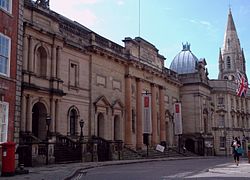Shire Hall, Nottingham
| Shire Hall | |
|
Nottinghamshire | |
|---|---|
 The Shire Hall | |
| Type: | Shire hall |
| Location | |
| Grid reference: | SK57603961 |
| Location: | 52°57’3"N, 1°8’39"W |
| City: | Nottingham |
| History | |
| Address: | The Lace Market |
| Built 1770-1772 | |
| By: | James Gandon |
| Shire hall | |
| Neo-claassical | |
| Information | |
| Website: | nationaljusticemuseum.org.uk |
Shire Hall stands on High Pavement in the Lace Market in Nottingham, the sole city of Nottinghamshire. It was built in 1770-1772 as a court house and headquarters of the justices of the county, and today is a museum: the National Justice Museum (formerly known as the 'Galleries of Justice Museum').
The museum is an independent museum, run by the National Justice Museum, a registered charity.[1]
The building Victorian courtroom, gaol and police station, and is therefore a historic site where an individual could be arrested, sentenced and executed.
The courtrooms date back to the 14th century and the gaol to at least 1449. The building was used as a police station from 1905 to 1985, and the courts closed in 1986.
Contents
History
Predecessors
The site has apparently been that of a shire hall of sorts since Norman days, if not before: the site has been referred to as the Sheriff's Hall, the County Hall or the King's Hall, as the place where the sheriffs of Nottinghamshire (in the days when that position held power) administered justice and taxation. The first written record of the site being used as a law court dates from 1375. The first written reference to its use as a prison is in 1449.[2]
An early modern shire hall was built here, incorporating both a court house and a prison, which were developed and enlarged over the years. In 1724, the courtroom floor collapsed. The Nottingham Courant in March 1724 recorded:[2]
On Monday morning, after the Judge had gone into the County Hall, and a great crowd of people being there, a tracing or two that supported the floor broke and fell in and several people fell in with it, about three yards into the cellar underneath. Some were bruised, but one man named Fellingham was pretty much hurt, one leg being stript to the bone, and was much hurt. This caused great consternation in Court, some apprehending the Hall might fall, others crying out "Fire!" etc. which made several people climb out of the windows. The Judge, being also terribly frightened, cried out "A plot! A plot!", but the consternation soon being over the Court proceeded to business.
Today's Shire Hall
A new Shire Hall was built between 1769 and 1772.[3] The architect was James Gandon from London, and the cost about £2,500. The builder was Joseph Pickford of Derby. Gandon designed the hall in the neo-Classical style. It has later additions in Italian Renaissance style.
The inscription on the top of the building reads:
This County Hall was erected in the year MDCCLXX and in the tenth year of the reign of His Majesty George III.
The building was fronted by an iron palisade to help control unruly crowds on the occasion of a public hanging.
Beneath, and at the rear and extensive rock-hewn caves and cells of the eighteenth century and earlier, and various nineteenth-century brick additions, including retaining walls to the cliff.
Nineteenth century
Additional wings were added between 1820 and 1840. Changes were made to the nisi prius court in 1833. The judges' retiring room, barristers' robing room and office for a clerk were added in 1844.[4]
A new grand jury room was added in 1859 to designs by the architect Richard Charles Sutton.[4] The last public execution was held in 1864 when Richard Thomas Parker was hanged.
In 1876 major improvements were made and the front was redesigned in a style described as Italianate by William Bliss Sanders of Nottingham. Within a few weeks a fire broke out and nearly destroyed all of the newly completed work.[5] Following the fire, the courts were largely rebuilt by Thomas Chambers Hine between 1876 and 1879.
The gaol was closed in 1878.[4]
Twentieth/twenty-first centuries
A police station was added beside the building in 1905. The Shire Hall continued in use as Nottingham's civil and criminal courts until 1991, when Nottingham Crown Court was opened at Canal Street.
The Galleries of Justice Museum opened in the building in 1995. It was refurbished and rebranded as the National Justice Museum in 2017. The building houses two courtrooms, the underground jail and a site used for executions.
Exhibitions
The Crime Gallery includes a range of family activities, interactives and exhibitions exploring a range of topics relating to crime. This area also includes the dock from Bow Street Magistrates' Court.
Outside links
| ("Wikimedia Commons" has material about Shire Hall, Nottingham) |
References
- ↑ National Justice Museum - Registered Charity no. 1030554 at the Charity Commission
- ↑ 2.0 2.1 Brand, Ken. The Shire Hall and Old County Gaol Nottingham p.1. Nottingham Civic Society. ISBN 0950486132.
- ↑ National Heritage List 1254517: Shire Hall and adjoining County Gaol
- ↑ 4.0 4.1 4.2 Ordering law: the architectural and social history of the English law court. Clare Graham
- ↑ Nottingham Daily Express, 4 December 1876.
